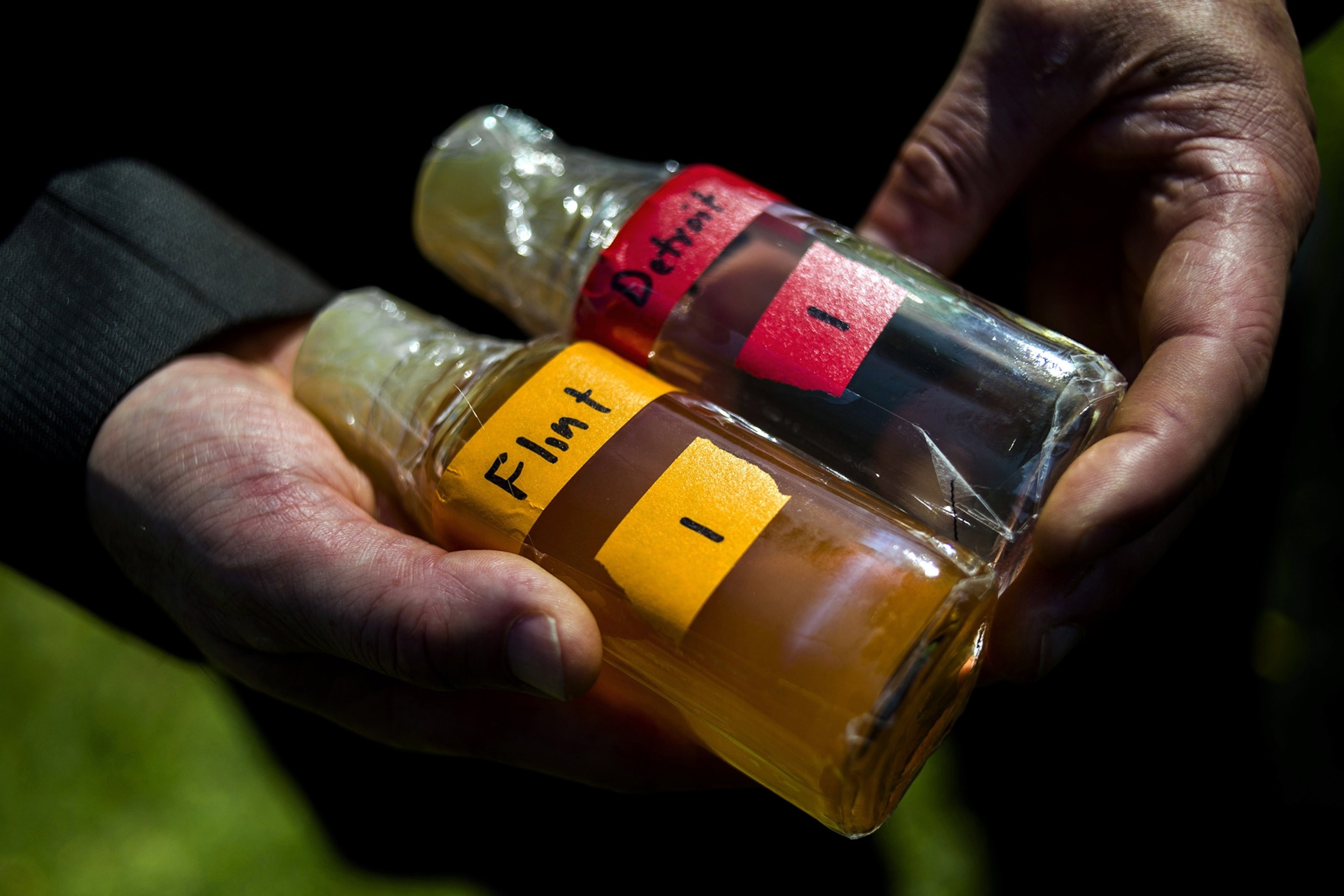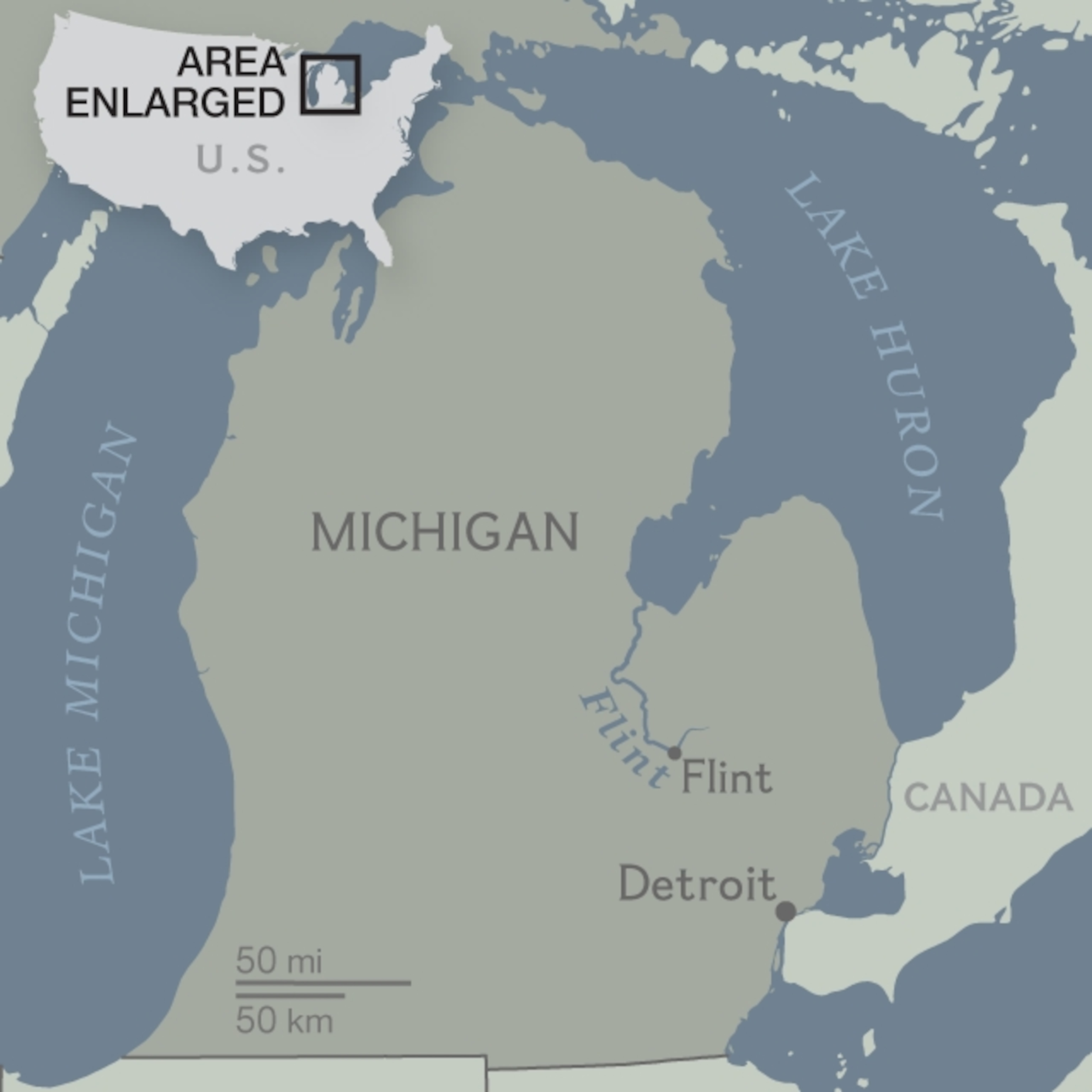
Could What Happened in Flint Happen Anywhere?
Other U.S. cities, particularly in the Northeast and Midwest, could face the same water crisis because millions of utility lines contain lead, a potent poison.
Flint’s crisis with drinking water contamination has been cast as a unique series of fumbles and cover-ups. But the Michigan city’s plight also illustrates a much wider concern: Millions of Americans drink water that flows through lead pipes, fittings, and solder, most installed before the 1970s.
Lead pipes can be found in much of the U.S., but surveys show they are concentrated in the Northeast and Midwest. Nobody really knows how extensive they are today: A 1990 study estimated that 3.3 million utility service lines contain lead—plus twice as many connecting pipes, and countless amounts of lead solder. In addition, many homes have plumbing that contains the hazardous metal.
If utilities don’t carefully balance water chemistry and treatment methods, and if regulators don’t enforce the rules, lead can leach from utility pipes and household plumbing systems and wind up in people’s water. That’s what happened in Flint. A decade ago, it happened in Washington, D.C., too. About 640,000 District of Columbia residents were exposed to lead when changes in disinfection chemicals allowed lead to leach from pipelines.
And health experts warn that the same crisis could happen again elsewhere, especially as local and state public health budgets shrink.
“If we have functioning public health agencies and water authorities, families shouldn't need to worry about it,” says Dr. Bruce Lanphear, an expert on lead’s medical effects at Simon Fraser University in Vancouver, Canada. “Unfortunately, we have starved public health, we have neglected lead hazards, and we have failed to maintain our public health infrastructure,” he says.
State and federal regulators have failed repeatedly to enforce rules governing lead in water, says Marc Edwards, a Virginia Tech scientist. He documented the extent of the contamination problems in both Flint and Washington.
“The system is hard on trust,” says Edwards, a civil engineering professor.


“Unfortunately, it’s not trustworthy. They’re not doing the job they’re being paid to do.”
Double the Lead
In Flint, Edwards’ study found lead levels in the drinking water nearly twice the amount that is supposed to trigger action under U.S. Environmental Protection Agency standards.
Lead is known to cause an array of neurological effects in children, including reduced IQ and aggressive behavior. Experts say there’s no safe level of exposure, since doctors have found effects from tiny amounts. In a 6-month-old weighing 18 pounds, it takes just 12 millionths of an ounce of lead in the child’s bloodstream– about the same as one grain of salt – to exceed the level that the Centers for Disease Control considers a risk for children.
Water system operators say they’ve reduced lead significantly since 1991, when the U.S. Environmental Protection Agency first adopted a rule that mandates monitoring and treatment to reduce contamination caused by corrosion and other factors related to lead pipes. They say calamities like those in Flint and the District of Columbia are rare because most systems follow the rules.
“In general, lead is pretty well managed across the country,” says Steve Via, regulatory affairs manager for the American Water Works Association, which represents water systems across the United States.
In Flint and in Washington, D.C., however, a failure of routine oversight by the EPA and others seems to have been at least partly at fault. The Safe Drinking Water Act governs about 155,000 public water systems nationwide, from small summer camps to huge urban utilities. The rules for big systems require steps to limit lead contamination from corrosion in pipes, solder, and fittings.
Under the law, Flint was required to take those steps after a state emergency manager who was temporarily running the financially-strapped city switched the water source from Detroit, which uses Lake Huron, to the cheaper Flint River.
Michigan officials were supposed to make sure Flint had adjusted its treatment methods to match the river water, which had different chemical properties than the water from Lake Huron.
EPA officials were responsible for oversight. But emails show that the EPA’s regional administrator didn’t want an EPA staffer’s concerns made public. Rather than ordering action or publicly warning parents when the state didn’t act, she argued for months with Michigan officials, who were insisting – wrongly -- that the water was safe.
The EPA regional chief, Susan Hedman, resigned on Jan. 21. That same day, the EPA inspector general launched a review of the region’s drinking water oversight and Administrator Gina McCarthy issued an emergency order mandating immediate steps by Michigan officials.
EPA officials had promised better scrutiny of the states after the District of Columbia’s lead problem in 2004.
In a letter last week sent to Michigan Gov. Rick Snyder, McCarthy cited “serious and ongoing concerns with the safety of Flint’s drinking water system,” including “continuing delays and lack of transparency” in the state’s response.
President Barack Obama, during a visit to Detroit last week, echoed public frustration with the slow response to the city’s health emergency.

“And I know if I was a parent up there,” Obama said, “I would be beside myself if my kids’ health could be at risk.”
Half a Million US Kids
Lead has been part of human life for millennia – the Romans used it for dinnerware – and it remains so today. It’s in car batteries, bullets, and shotgun shells and shields patients and technicians from X-rays.
It used to be in U.S. gasoline and house paint, too, but those were eliminated by federal orders – milestones in reducing lead exposures.
Still, the CDC says half a million U.S. children from 1-5 years old have lead levels that exceed the guideline of 5 micrograms per deciliter of blood.
“Lead exposure has declined dramatically over the past three to four decades, but it remains a major public health problem,” says Lanphear. “Our blood lead levels are 10-100 times higher than our pre-industrial ancestors.”
Lead pipes for water, long favored because the metal is easily formed, were known to be a risk by the 1700s, but they were widely installed in many countries until the mid-twentieth century.
Sometimes lead leaches from pipes because the water’s too acidic. Sometimes it happens because the water has high levels of chlorides or treatment changes strip off lead-containing corrosion. And sometimes the water just sits too long in the pipe, slowly eating away at the lead.
There’s a technical solution for each of those problems, although the science and engineering of controlling corrosion is especially complex and deep expertise is scarce. For Virginia Tech’s Edwards, however, spotting the local, state, and federal failures in Flint was easy.

“I knew exactly what happened the moment I saw the chemistry of the water,” he says. “Either my 25 years of experience and knowledge are wrong, or they were flat-out lying. The laws are not different in Flint.”
Expensive to Fix
The ultimate answer is to rip out all the lead service lines and replace them with lead-free alternatives. That was a recommendation of a federal panel’s report in December.
But there’s no money for a comprehensive program. EPA rules can require utilities to remove lead pipes, but only when all other measures have failed to reduce lead in the water. Even then, a whole line must be removed, since taking out just part of a line can worsen the contamination because lead gets knocked loose.
Another problem is that the line from the street to the home, and the plumbing within the home, also can contain lead, but those fixtures belong to the property owner, not the utility. Utility operators have used this point to argue against making water systems responsible for replacing them at several thousand dollars per house.
Until all lead pipes are gone, the stopgaps must suffice, experts say. Those include better monitoring – at the plant, in mid-system, and at people’s taps – as well as better treatment, aggressive enforcement and parent education.
Without a sound system for protecting public health, parents should consider testing their own water and making sure that dust from old paint is controlled when renovating a home.
Edwards says the cheapest prevention is for utilities to obey the EPA rules. Flint’s mayor has said replacing the lead pipes could cost $1.5 billion – plus the cost of possible health damage. By contrast, Edwards says the treatment chemicals that would have kept the lead out of the water would have cost $80-$100 a day.
“If we just would observe the intent of the original rule,” he says, “I would be happy.”








